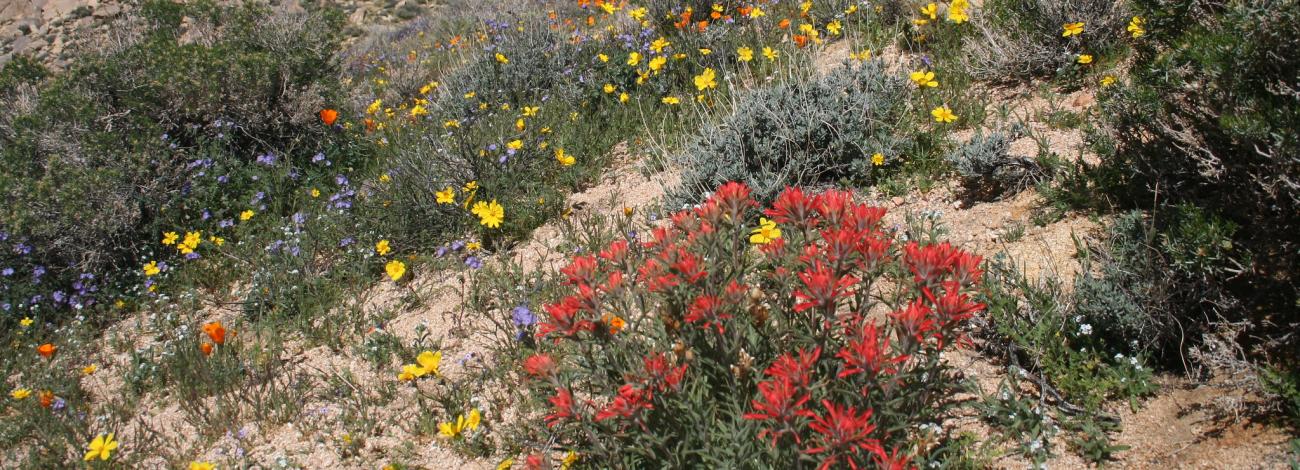
Mojave Desert Native Plants: Biology, Ecology, Native Plant Materials Development, and Use in Restoration
The Mojave spans a portion of southern California, southern Nevada, southwestern Utah, and northwestern Arizona. Although noted as the driest of the North American deserts, the Mojave hosts a diversity of native plant species uniquely adapted to the region’s conditions. Plant diversity is in part driven by overall landscape heterogeneity, marked by basin and range topography.
Increasing fire frequency due to invasive grasses presents a major threat to Mojave ecosystems. Impacts from recreation, energy development, and urban development further alter native plant communities throughout the region. Revegetation in the Mojave is challenging due to unpredictable precipitation, frequent drought, and heavy pressure from granivores and herbivores.
A lack of locally adapted seed and nursery stock also limits restoration capacity. To address this need for appropriate seed, the Bureau of Land Management’s Mojave Desert Native Plant Program facilitates and funds plant materials development, research, and tools development to guide restoration. This guide supports the Program’s efforts to increase seed availability and knowledge specific to the Mojave Desert.
Mojave Desert Native Plants Guide
Mojave Desert Native Plants is a guide to priority native plants for restoration in the Mojave Desert Ecoregion (the Mojave). Modeled after Western Forbs: Biology, Ecology, and Use in Restoration, the guide features forbs, shrubs, and grasses of interest for native plant materials development and restoration in the Mojave. Species featured in the guide include notable forage and cover plants for the federally endangered desert tortoise (Gopherus agassizii). Many of these species have additional benefits for pollinator support, invasive species competition, and biodiversity restoration.
Each chapter details a species’ biology, ecology, and methods that have been used for seed collection, nursery propagation, seed increase, and restoration, including lessons from both failures and successes. Definitive techniques are often unestablished for Mojave species. Species with established nursery propagation and seed increase protocols using seed sourced from other ecoregions may respond very differently when seed is sourced from Mojave populations. For this guide, therefore, we have compiled techniques that different collectors and growers have used in the past, along with their observed results. This guide is intended to serve as a resource for seed collectors, nursery growers, seed producers, landowners, restoration practitioners, and natural resource managers in federal, state, and tribal agencies.
- Acton's Brittlebush
- Big Galleta
- Brittlebush
- Bush Muhly
- Creosote
- Desert Chia
- Desert Globemallow
- Desert Marigold
- Desert Milkweed
- Desert Needlegrass
- Desert Plantain
- Eastern Mojave Buckwheat
- Fringed Amaranth
- Indian Ricegrass
- Mojave Aster
- Palmer's Penstemon
- Pincushion Flower
- Smooth Desert Dandelion
- Virgin River Brittlebush
- White Bursage
- Yellowcups
Methods and Funding
Mojave Desert Native Plants was developed through extensive literature review to synthesize available information, as well as interviews with growers and restoration practitioners who hold applied and regional knowledge. While some featured species have ranges that extend beyond the Mojave Desert Ecoregion, information is presented with a focus on Mojave ecotypes when available.
Development of Mojave Desert Native Plants was accomplished by Institute for Applied Ecology with funding from the Bureau of Land Management, Mojave Desert Native Plant Program.
Acknowledgements
Thank you to Judy Perkins (BLM) for initiating and supporting this project.
The conceptual framework and design of the Mojave Native Plant Guide was developed by Corey Gucker (Great Basin Fire Science Exchange) and Nancy Shaw (U.S. Forest Service) in Western Forbs: Biology, Ecology, and Use in Restoration.
Thank you to the following individuals who shared their knowledge on growing or using these species for restoration:
- Lou Thomas, Living Desert Zoo and Gardens
- Shanna Winters, Living Desert Zoo and Gardens
- Lexi Beaty, Living Desert Zoo and Gardens
- Dakota Brooks, Victor Valley College
- Dolores Gault, Victor Valley College
- Steve Plath, Desert Seed Resource Center
- Madena Asbell, Mojave Desert Land Trust
- Jean Graham, Joshua Tree National Park
- Kelly Wallace, Lake Meade National Recreation Area
- Susi Corona, Institute for Applied Ecology
- Damon Winters, L&H Seeds
- Ed Kleiner, Comstock Seeds
- Tren Hagman, Granite Seeds
- Dash Hibbard, Walker Basin Conservancy
- Billy Sale, California Botanic Garden
- Anthony Perez, California Botanic Garden
- Amy Johnson, Las Vegas State Tree Nursery
- Heather Dial, U.S. Department of Agriculture, Natural Resources Conservation Service
- Eninka Mndolwa, U.S. Department of Agriculture, Natural Resources Conservation Service
- Lesley DeFalco, U.S. Geological Survey
- Dash Hibbard, Walker Basin Conservancy
